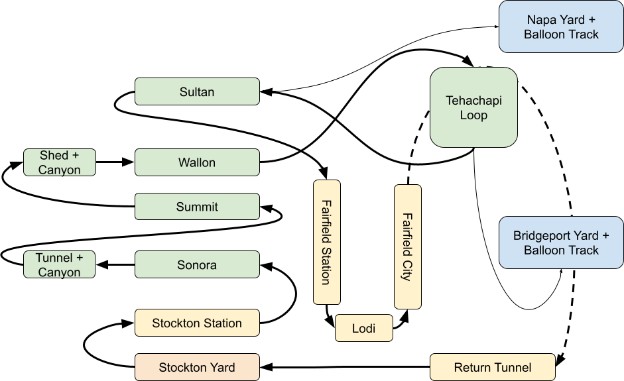The Randall Museum in San Francisco hosts a large HO-scale model model railroad. Created by the Golden Gate Model Railroad Club starting in 1961, the layout was donated to the Museum in 2015. Since then I have started automatizing trains running on the layout. I am also the model railroad maintainer. This blog describes various updates on the Randall project and I maintain a separate blog for all my electronics not directly related to Randall.
2022-05-14 - Layout Topology and Reversing Loops
Category RandallHere’s a schematic representation of the Randall Museum Model Railroad track:
The dark line indicates the current running direction. Green blocks are features in the Mountain division, and yellow blocks are features in the Valley division. The two secondary yards with their balloon reversing tracks are denoted in blue. Stockton Yard is the staging yard and starting point and is denoted in red.
Now the schema above is a bit messy as it vaguely represents the physical location of each feature in the room, with the track that keeps crossing over itself lots of times via bridges and tunnels. I even omitted the Branchline, which confusingly adds another reversing loop from Sonora back to Stockton Station or Stockton Yard.
However, since we mostly have a single mainline running loop, we can reorganize the schema and simplify it as follows:
This track schema is strictly equivalent to that spaghetti mess above.
Here it’s easier to see that Saturday operators basically run a glorified 4x8 oval loop, with two yards providing balloon tracks.
Now this opens some interesting operational considerations.
For example, let’s say there’s a problem East of the Tehachapi Loop and trains can’t reach Sultan. This happened when we had that dead spot at T173 before I fixed it. In that case trains can diverge to the Bridgeport Yard and use the balloon track here to reverse direction.
In that scenario, one may be tempted to stop at Stockton Yard on the way back, essentially ignoring half of the layout:
But in fact there’s a clever way as trains can again continue past the yard, reach Sultan in the reverse direction and from there diverge to the Naya Yard and use its balloon track. The layout schema now looks like this:
I sometimes use this running scheme when running alone to do my train videos. It allows me to film the same train running in opposite directions at the same spot.
When multiple operators are running several trains, this does require some coordination since they will be potentially running in opposite directions on the single track mainline. That’s why the track, mirroring the prototype SP, features multiple sidings where trains can wait and pass each other in opposite directions. However because operators typically run in a single loop, they tend to forget about these sidings and don’t use them, thus not forming a habit of how to use them. And since we don’t use them, we tend to not maintain them, or voluntarily condemn them during maintenance. Using sidings is complex as the panels are far from obvious to use, can be quite error prone, and it requires careful coordination between operators and their trains.
Stockton Yard is an obvious choice of a long and convenient siding that all operators know how to use. Recently I refurbished the T80-T90 siding (from Lodi to Fairfield) which can also be used easily.
However, here that scheme can also be simplified. If two operators are running, they can simply agree to all run in the same direction towards the same yard and wait for each other before continuing -- for example:
- Start from Stockton to Bridgeport, and then wait for each to arrive.
- Only leave Bridgeport once the mainline is known to be clear of any running trains.
- Run the trains from Bridgeport toward Stockton, proceed to the Napa yard, and then wait for each to arrive.
- Only leave Napa once the mainline is known to be clear of any running trains.
- Rinse and repeat.
This is more or less the concept of train orders after all… Some consideration needs to be done to ensure the trains can fit in the balloon tracks, or park them temporarily.
Using the concept of train orders, Stockton Yard is ideal because all operators are familiar with it, so here’s another potential running scheme:
- Operator A runs from Stockton Yard towards Napa, reverses there, then heads back to Stockton Yard.
- Operator B runs from Stockton Yard towards Bridgeport, reverses there, then heads back to Stockton Yard.
- Before reaching Stockton Yard, they should both have agreed on which siding (inner or outer) each one takes.
- They both wait for each other at Stockton Yard. Once they have a meet, then can continue:
- Operator A runs from Stockton Yard towards Brideport, reverses there, then heads back to Stockton Yard.
- Operator B runs from Stockton Yard towards Napa, reverses there, then heads back to Stockton Yard.
- Every time they meet in Stockton Yard, keep swapping destinations (which naturally match the direction of their running train), and they are guaranteed to have the whole track in front of them free for themselves.
For all this to happen, effective CRM is primordial, which is generally where the willingness of some people stops.



